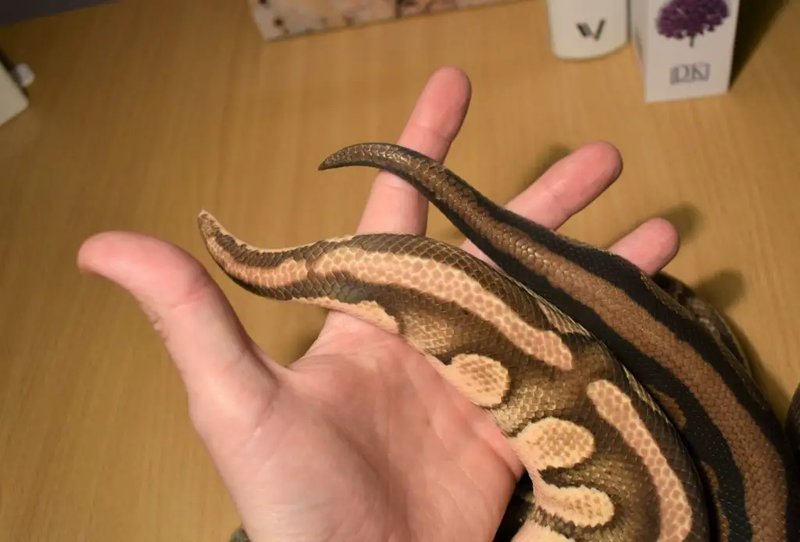
First, let’s break down why it matters. Understanding the gender of your snake can help you provide better care and make more informed decisions about breeding or keeping them in pairs. But don’t worry if you’re just starting; you don’t have to be a snake expert to figure this out. With a bit of patience and observation, you’ll quickly pick up on the differences.
Physical Characteristics: The First Clue
One of the easiest ways to tell the gender of your ball python is by observing their physical features. Here’s what to look for:
- Body Shape: Male ball pythons tend to have a more slender body shape, especially as they mature, while females usually have a wider, more robust body. This difference is particularly noticeable when they’re next to each other.
- Tail Length: Males often have longer tails compared to their body length, while the females’ tails tend to be shorter and thicker. This can be a subtle but helpful indicator.
Picture it like this: it’s similar to how you might notice the difference between a slender guy and a more rounded woman if you saw them standing side by side. The tail difference is particularly unique and can be a significant help when you’re unsure.
Hemipenes: The Gender Secret
Okay, here’s where it gets a bit technical but bear with me. Males have a couple of special organs called hemipenes. These are like their version of reproductive organs, and they’re not always visible unless you know where to look.
To check for hemipenes, you can gently handle your snake. Here’s how you can do it:
1. Hold the snake securely, being careful not to squeeze too hard.
2. Gently lift the tail and look for a small bulge near the base. If you spot two bulges, that’s a clear sign you’re looking at a male.
3. If the tail looks smooth without any bulges, you’re likely holding a female.
Just remember, this can take a little practice, so don’t be discouraged if you don’t nail it the first time. Think of it like learning to read a map. With time, it becomes easier.
Behavioral Traits: Another Insight
Apart from physical traits, sometimes behavior can give you clues about a ball python’s gender. Males may display more exploratory or territorial behavior compared to females. Here’s what to consider:
- Mating Season: During mating season, males might be more active, especially if they sense a female nearby.
- Handling Preferences: Some owners believe that males may not mind being handled as much, while females can be a bit shyer, but this can vary based on individual snake personalities.
It’s not a hard-and-fast rule, but these behaviors can sometimes give you additional hints. It’s like trying to guess what type of dog someone has based on how they act—sometimes, you can just tell!
How to Size Up with a Vent Check
If you feel comfortable, you can perform a vent check, which is one of the most accurate methods to determine the gender of your ball python. Here’s a step-by-step guide:
1. Position Your Snake: Lay your python gently on a flat surface, ensuring it’s calm.
2. Locate the Vent: The vent is a small opening located on the underside of the tail, about a third of the way down from the body.
3. Gentle Pressure: Apply a little pressure to either side of the vent. If you see a small, elongated bulge, congratulations! You’re handling a male. If it looks smooth, it’s likely a female.
While this can seem a bit intimidating, it’s important to be gentle and patient. Think of it like checking for a rip in your sweater: a little pressure can reveal a lot.
Age Matters: Timing the Gender Check
Age plays a role in how easily you can determine your ball python’s gender. Young snakes can be particularly tricky, as their physical differences are not as developed yet. Here’s what to keep in mind:
- Hatchlings: It’s generally not recommended to determine gender before they’re around 6 months old, as their features are still very subtle.
- Juveniles: By the time they reach 1 to 2 years old, you should have a clearer idea of their gender through physical and behavioral cues.
Imagine trying to guess the gender of a child; it’s not easy when they’re so young! With ball pythons, waiting for them to grow a bit can make your job a lot easier and more accurate.
Using Genetic Traits for Identification
If you’re really into breeding or just curious, genetic traits can sometimes help you identify gender as well. Some genes are linked to gender in ball pythons. For example, certain morphs are more commonly male or female in specific breeding lines.
If you’re working with specialized breeders, ask them about the genetics behind their snakes. It’s like learning a family tree; knowing the background can give you insights not only into appearance but also into which snakes might carry particular traits.
Why Gender Matters for Ball Python Owners
Understanding the gender of your ball python isn’t just a fun fact; it can help you decide if you want to breed snakes or ensure a harmonious environment if you have more than one. Males and females can display very different behaviors, especially during breeding season.
If you’re trying to breed, knowing the gender is obviously essential, but even if you’re not, this knowledge can influence your snake’s care. It’s like knowing whether you’re raising a puppy or a kitten—each has its own needs!
In conclusion, figuring out the gender of a ball python can be straightforward if you know what to look for. From examining physical traits, behavior, and even conducting a vent check, you have several options at your disposal. By paying attention and being patient, you’ll become skilled at identifying your snake’s gender in no time. Just remember to enjoy the process; after all, you’re learning about a wonderful creature that can become a great companion.

